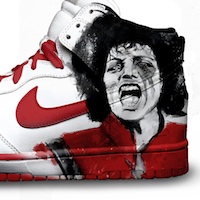It will be determined in a court of law and like I said it's not an easy determination. A judge will look to several factors and it could be classified as either one..
yes photographs and likeliness could be copyrighted and trademarked but then you have the first amendment rights of people (and artists). Courts will look to the intent, whether there was fair use, the transformation /transformative factors (whether the artist added something to the image such as their own interpretation etc).. Also some images could be classified under "creative commons", allowing artists to reuse them...
In short there are too many factors here to say it for certain.. Estate can definitely sue if they want but we can't predict the outcome without knowing all the factors.
(Plus I think [correct me if I'm wrong) these are made to order, hand painted sneakers - it doesn't look a like a mass produced item in high numbers)
here's an interesting info about when Tiger Woods sued about using of his image/picture in a painting and lost..
oh another interesting thing : Andy Warhol's paintings of celebrities are also seen okay by the law as they are transformative enough and adds a whole different meaning to the picture used.. The following is from court documents
This is an interesting area of law that still seems to be being worked out on a case by case basis. Mr Brainwash lost against a photographer who held the copyright to images MBW 'transformed' in to prints...but apparently not enough
Arts News
Judge Rules Run-DMC Photo, Used by L.A. Street Artist Mr. Brainwash, Protected by Copyright Law: What Will It Mean for Fair Use?
By Simone Wilson Fri., Jun. 10 2011 at 1:45 PM Categories: Arts News
Mr. Brainwash just got busted.
?Forget the Shepard Fairey case. Music photographer Glen E. Friedman's lawsuit against Mr. Brainwash, the street artist profiled alongside Banksy in Oscar-nominated doc "Exit Through the Gift Shop," is the one to watch for legal fair-use precedent.
It all started with a 2008 installation in Los Angeles called "Life Is Beautiful," at a peaceful time when Mr. Brainwash was still an enigma --
Perhaps even a faction of Banksy's colorful imagination. (The LA Weekly knew better: We profiled Thierry Guetta in "Mr. Brainwash Bombs L.A.," back when he was "about to unleash an art happening at Columbia Square so audacious in scale and ambition that it will either make him an instant art star or an object of derision, a high-profile lesson in the perils of the vanity DIY spectacle.")
But one of the pieces in the exhibit made something entirely different of Guetta: He's now a copyright-law Guinea pig.
According to the Hollywood Reporter, a Run-DMC photo that the street artist employed in his first big mainstream show (see below) was ruled "copyright protectable" in a California federal court yesterday. This was based on the relative artisticness of Friedman's orginal photo, including "decisions about light and shadow, image clarity, depth of field, spatial relationships and graininess."
Unlike in Fairey's case, where the Obama photographer didn't even recognize her own work once the artist had his way with it, Judge Dean Pregerson made the devastating call that Guetta's Run-DMC piece doesn't differ enough from the original, and thus cannot be defended in future hearings as "transformative fair use":
The judge examines the four factors of the fair use test, including (1) the purpose and character of use; (2) the nature of the copyrighted work; (3) the amount and substantiality of the portion used in relation to the copyrighted work as a whole; and (4) the effect of the use upon the potential market for the copyrighted work, and determines that Guetta can't satisfy his burden in establishing this defense.
Compare the two pieces for yourself (and check some of Guetta's further manipulations of the image at Boing Boing):
?The Associated Press' lawsuit against Fairey, for his use of their Obama photo in his "HOPE" poster, was eventually settled outside the courtroom. The anticlimactic agreement wasn't exactly a win for the "more art" ideal -- the AP now shares all profits generated by the "HOPE" image and Fairey promises not to look at any AP photos for inspiration -- but the Run-DMC case is building new walls for artists.
?Telling an Andy Warhol disciple like Mr. Brainwish that gluing 1,000 broken record pieces over the silhouette of a classic hip-hop trio isn't arty enough to be protected by law is a huge setback in the age of mashups and multimedia collage.
According to the recent book Common as Air, Western copyright law was meant to enrich the common intellect without discouraging authors, artists and musicians from creating and enriching their own wallets.
The rules were meant to give creators very limited control. They were never meant, at least by this country's founders, to enrich private profiteers at the cost of public education and enjoyment.
At what point does something become so iconic that it belongs to all of us? Campbell's Soup never sued Warhol. Hey, it was free advertising. And that's how Friedman might have viewed Guetta's work, too -- if there was only room in Los Angeles for the two artists' egos.
And speaking of ego, Banksy's incognito approach is looking more and more attractive amid L.A. (and the nation's) street-art crackdown. It's only when an artist hungers for public recognition that his work is subjected to other artists' territorial hissy fits and, eventually, the fun-killing authority of the U.S. court of law.
http://blogs.laweekly.com/informer/..._street_artist_mr_brainwash_copyright_law.php







